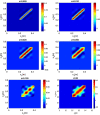Wigner distribution function approach to analyze MIMO communication within a waveguide
- PMID: 36895377
- PMCID: PMC9989644
- DOI: 10.1016/j.heliyon.2023.e13929
Wigner distribution function approach to analyze MIMO communication within a waveguide
Abstract
Multiple-input-multiple-output (MIMO) communication is a technology to create high capacity wireless links. The main aim of this paper is to provide a foundation to mathematically model wireless chip to chip communication within complex enclosures. This paper mainly concentrates on modelling wave propagation between transmit and receive antennas through a phase space approach which exploits the relationship between the field-field correlation function (CF) and the Wigner distribution function (WDF). A reliable model of wireless chip-to-chip (C2C) communication helps mitigate the information bottleneck caused due to the wired connections between chips, thus, help improve the efficiency of electronic devices of the future. Placing complex sources such as printed circuit board (PCB) inside a cavity or enclosure results in multi-path interference and hence makes the prediction of signal propagation more difficult. Thus, the CFs can be propagated based on a ray transport approach that predicts the average radiated density, but not the significant fluctuations that occur about it. Hence, the WDF approach can be extended to problems in finite cavities that incorporates reflections as well. Phase space propagators based on classical multi-reflection ray dynamics can be obtained by considering the high-frequency asymptotics.
Keywords: Correlation function; MIMO communication; Waveguide; Wigner distribution function; Wireless C2C communication.
© 2023 The Author(s).
Conflict of interest statement
The authors declare no competing interests.
Figures









References
-
- Muot Nathanael, Girard Christophe, Ferrieres Xavier, Bachelier Elodie. A combined fdtd/tlm time domain method to solve efficiently electromagnetic problems. Prog. Electromagn. Res. 2013;56:409–427.
-
- Tanner Gregor. Dynamical energy analysis—determining wave energy distributions in vibro-acoustical structures in the high-frequency regime. J. Sound Vib. 2009;320:1023–1038.
-
- Miller David A.B. Communicating with waves between volumes: evaluating orthogonal spatial channels and limits on coupling strengths. Appl. Opt. 2000;39:1681–1699. - PubMed
-
- Miller David A.B. Proceedings-Spie the International Society for Optical Engineering. 1998. Communicating with waves between volumes: how many different spatial channels are there? pp. 111–114.
-
- Gradoni Gabriele, Madenoor Ramapriya Deepthee, Creagh Stephen C., Tanner Gregor, Hafiz Baharuddin Mohd, Nasser Hayan, Smartt Christopher, Thomas David WP. Near-field scanning and propagation of correlated low-frequency radiated emissions. IEEE Trans. Electromagn. Compat. 2017;60(6):2045–2048.
LinkOut - more resources
Full Text Sources

